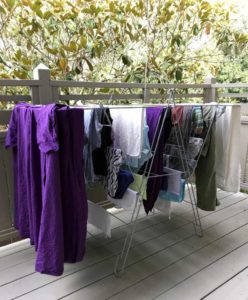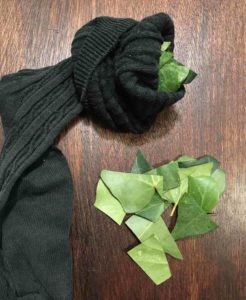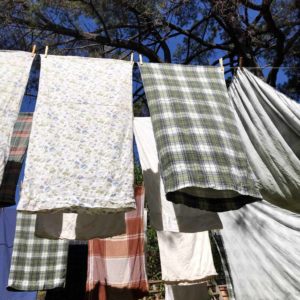(With apologies to Michael Pollan for another riff of his quote, “Eat food. Not too much. Mostly Plants.”)
Why Does She Keep Posting Pictures of Her Underwear?
Every several months, I’ll post a picture on Instagram of my laundry drying outside on my drying rack. I hear two basic reactions.
- Americans: “OMG where did you get your drying rack? I’d love one like it.”
- Everyone else: “Why are you posting this?”
In most of the world, hanging up clothes to dry is normal, non-Instagrammable behavior. Here in the US, where many home owners associations (HOAs) ban “unsightly” clotheslines, hanging up your laundry to dry like god intended racks up the likes and confers rebel status. Many of these HOA bans appear to be illegal, however.
Laundry rule #1: Wash only when dirty
You will save time, energy and money by washing clothes only when they actually need it. Unless I spill tea all over myself while sitting at my desk writing and editing all day on my laptop, my clothes stay clean. I’ll wear even my wool or cotton socks for (at least) a couple of days in a row if they pass the sniff test.
Washing
Although I hang my clothes to dry, I have not begun to manually wash them by beating them against rocks except for that one time in the Caribbean while skinny-dipping. I do use a washing machine.
Use cold water
- Heating water for a load of laundry consumes 90 percent of the total energy required to wash that load.
- Hot water breaks down fabric faster than cold water does. Washing synthetic fabrics—polyester, acrylic and blends—in cold may shed fewer plastic microfibers. A typical load can shed 700,000 of these tiny plastic fibers, which enter our waterways and all levels of the ocean food chain, from plankton to marine mammals—and eventually us.
- Clothes washed in cold last longer. You’ll repair and replace them less often and thus buy fewer clothes.
Avoid the delicate cycle
A recent study found that the delicate cycle can release an additional 800,000 plastic microfibers. The study revealed that the more water used, the more plastic microfibers released. The delicate cycle uses up to two times as much water as the regular cycle.
While washing machines cannot capture these microfibers, Guppyfriend bags, which Patagonia sells at cost, reduce the amount of microfibers that washing machines release.
Wash full loads
Get your money’s worth and do full loads. Whether you wash two towels or a full load, your machine will use the same amount of energy to wash them.
Skip the fabric softener
When your nose detects a fragrance, your brain should think phthalates. Fabric softeners may contain these endocrine disruptors. Studies have linked phthalates to an array of negative health outcomes, such as “hormone changes, lower sperm count, less mobile sperm, birth defects in the male reproductive system, obesity, diabetes and thyroid irregularities.” The Environmental Working Group (EWG), which rates the safety of household products, gives fabric softeners an abysmal F.
Check out ivy leaves as detergent
Let me start off by saying that I need to experiment with this method more and am by no means an ivy-as-detergent expert. For more adventures in washing with ivy, please read the posts of @cleareasmud on Instagram, who told me about this trick.
I’ve been cutting up large English ivy leaves (otherwise known as common ivy or Hedera helix), putting them in an old sock, tying up the end to keep the ivy from going all over the place and then throwing the sock into the washing machine. For my last load, I used 15 grams of leaves. Never use poison ivy leaves!
 Ivy leaves contain saponin, a natural detergent and foaming agent. (“Saponin” comes from the Latin word for soap, “sapo.”) Other sources of saponins include horse chestnuts, soapwort and soap nuts.
Ivy leaves contain saponin, a natural detergent and foaming agent. (“Saponin” comes from the Latin word for soap, “sapo.”) Other sources of saponins include horse chestnuts, soapwort and soap nuts.
I don’t know if the ivy works or the agitation of the machine alone cleans the clothes and we’ve all been duped into buying more products than we need. I do know my clothes come out clean. However, they don’t go in very dirty. Someone on Facebook told me that her family’s very dirty clothes come out of the wash clean with the addition of mere vinegar and no detergent.
 On my long to-blog list, I’ve added “make liquid detergent from ivy.” To do this, you simmer the leaves in water and strain. I hope it works well. (Go here for laundry detergent made from horse chestnuts.)
On my long to-blog list, I’ve added “make liquid detergent from ivy.” To do this, you simmer the leaves in water and strain. I hope it works well. (Go here for laundry detergent made from horse chestnuts.)
Drying
According to the US Energy Information Association (EIA), clothes dryers account for 5 percent of total household energy consumed in the US, while washing machines account for only 0.5 percent of household energy, not including the energy to heat the water in warm or hot loads.
If you dry laundry in a dryer
Spin it right round, baby right round
Spin your clothes in the washing machine for a longer amount of time than the standard cycle lasts. Your machine may have a high spin cycle or other cycle that you can set it to for a longer spin. This will reduce the amount of time your dryer will have to run to dry your clothes.
Buy a pair
I rarely use the dryer and so haven’t bought a pair of 100 percent wool dryer balls myself but people rave about them online. By absorbing water and increasing the air flow around laundry as it dries, these balls apparently reduce drying time. (As I said, I haven’t tried them myself.)
Look for an efficient model
When you replace your dryer, look for one with the Energy Star label. To earn this label, machines must be pass independent certifications while functioning well. If you can afford it, consider buying a heat pump dryer. These recycle the hot air in the dryer rather than wasting it by venting it outside.
Clean out the lint
Clean out the filter after drying each load. If the lint contains synthetic fibers, I would not add it to the compost pile.
Skip the dryer sheets
These single-use throwaway synthetic (i.e., plastic) sheets can, like fabric softener, contain phthalates. Avoid over-drying your laundry to avoid static electricity shocks.
If you hang laundry to dry
Buy clothes less often
Dryers break down fibers. Hang your laundry up to dry and it will last much longer. Yes, hanging takes more time but I find it meditative.
Send less money to your utility company
Instead of Zero-Waste Chef, I could have named this blog “Zero-Waste by Default for Frugal People.” You’ll save money if you hang up your clothes to dry or if you follow any of the tips I’ve listed in this post.
Does anyone actually like their utility company? Here in Northern California, PG&E sparked outrage in October for cutting off power to hundreds of thousands of residents after weather forecasts predicted high winds and severe fire risk.
A probe into the devastating Camp Fire of 2018, which killed 85 people and razed the town of Paradise, found that PG&E’s power lines ignited the blaze. The company, now in bankruptcy, could face more liability claims if its equipment starts more fires. Hence, the blackouts.
No one wants the state to endure another mega-fire. Outrage over the outages stemmed from the fact that PG&E has not updated its infrastructure and instead, inconvenienced a massive number of residents, some of whom had to evacuate their homes because of medical issues.
Hang up your laundry to dry and stick it to the man.
This article was written by Anne-Marie Bonneau and reprinted here with her permission. Read more on her website, The Zero Waste Chef.

